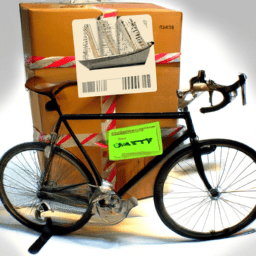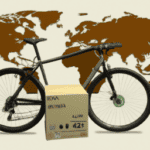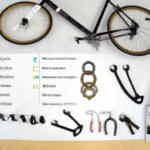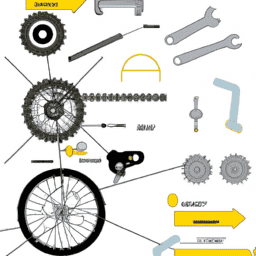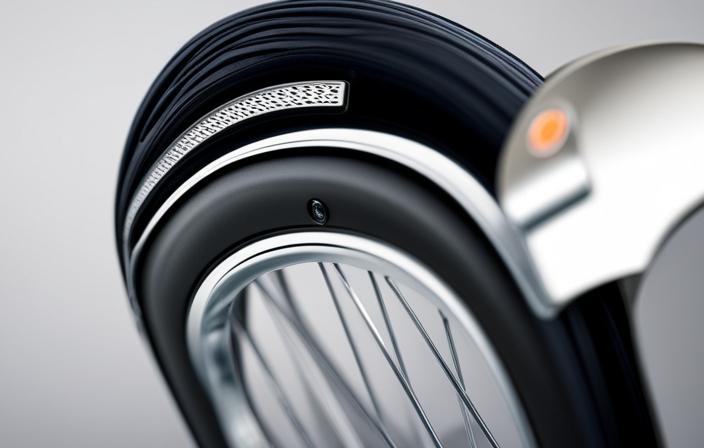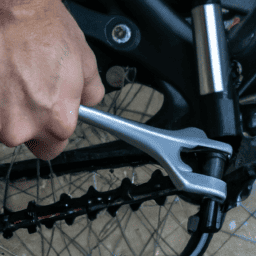Do you have plans to transport your bicycle but are curious about the potential costs involved? The price for shipping your bicycle is influenced by several elements, including your bike’s size and weight, the shipping option you select, and the carrier you decide to use.
To make an informed decision, you need to analyze and gather relevant data that will help you estimate the cost of shipping your bike.
Firstly, you need to determine the size and weight of your bicycle. This will help you choose the appropriate shipping method that will ensure your bike is safely transported without any damages.
Secondly, you need to research different shipping companies to compare their rates and services. This will help you make an informed decision on the company that will provide you with the best shipping experience at a reasonable cost.
With these factors in mind, let us dive into the details of how much it will cost you to ship your bicycle.
Key Takeaways
- Factors affecting shipping costs for bicycles include distance, package size, shipping method, and international customs fees and restrictions.
- Researching shipping companies and methods, disassembling the bike, and packaging each part securely can lower shipping costs.
- Obtaining quotes from multiple shipping companies, negotiating rates, and considering insurance coverage and tracking options can help find the most affordable and reliable option.
- Building a positive relationship with the shipping company can lead to more favorable rates in the future.
Determine the Size and Weight of Your Bicycle
Figuring out the size and weight of your bike is gonna be key in estimating shipping costs. Packaging considerations such as removing pedals, handlebars, and wheels can reduce the size and weight of your bike and therefore lower shipping costs.
Keep in mind that international shipping restrictions may also apply, so it’s important to research the regulations in the destination country before shipping.
To determine the size and weight of your bike, start by measuring the length, width, and height of your fully assembled bike. Then, remove any detachable parts and measure them separately. Finally, weigh each component and add them together to get the total weight.
Once you have these measurements, you can use them to get an accurate estimate of shipping costs. Now that you have the size and weight of your bike, it’s time to decide on the shipping method.
Decide on the Shipping Method
When it comes to shipping your two-wheeled ride, you’ll want to weigh the pros and cons of each available method. To help you make an informed decision, consider the shipping timeframe and any international regulations that may apply. Here’s a table outlining some popular shipping methods and their estimated costs:
| Shipping Method | Estimated Cost |
|---|---|
| Ground | $50-$100 |
| Air | $100-$300 |
| Parcel | $50-$150 |
| Freight | $200-$500 |
| Bike Box Express | $150-$300 |
It’s important to note that these estimated costs may vary depending on the size and weight of your bicycle, as well as the distance it needs to travel. Additionally, international shipping may come with additional fees and regulations. Make sure to do your research and understand any customs or import regulations that may apply to your shipment.
To ensure the best possible shipping experience, it’s crucial to research shipping companies and choose one that specializes in shipping bicycles. In the next section, we’ll discuss how to find a reputable shipping company that can safely get your bike to its destination.
Research Shipping Companies
When researching shipping companies for your bicycle, it’s important to compare prices, read reviews, and check for insurance and tracking options. You want to make sure you’re getting the best deal possible while also ensuring your bike is protected during transit.
By taking the time to research and compare different shipping companies, you can make an informed decision and have peace of mind knowing your bike is in good hands.
Compare Prices
You’ll be surprised at how much you can save when you compare prices for shipping your bicycle. Different shipping companies offer varying rates for their services, so it’s important to shop around and find the best option for your needs.
When comparing prices, consider factors such as shipping time and international shipping options, as these can greatly impact the overall cost. To get an accurate comparison, provide each shipping company with the same information about your bicycle, such as weight, dimensions, and destination. This will ensure that you receive comparable quotes and can make an informed decision.
Don’t forget to also check for any additional fees, such as insurance or packaging, as these can also affect the final price. By taking the time to compare prices, you can potentially save a significant amount of money on shipping your bicycle.
When you have found a few shipping companies that offer competitive rates, it’s time to read reviews to ensure that they provide quality service. Customer reviews can give you a glimpse into the experiences of others who have used the company’s services, allowing you to make a more informed decision.
Keep in mind that a few negative reviews should not necessarily deter you from using a particular company, but rather should be viewed as an opportunity to learn about potential issues and how the company responds to them.
Read Reviews
To ensure a positive experience with shipping your bike, it’s essential to check customer reviews and see what others have to say about the shipping company’s service. Taking the time to read reviews can provide invaluable insight into how a company operates, including their level of customer service, reliability, and overall performance.
Here are three things to keep in mind while reading customer experiences:
-
Look for patterns: While one bad review doesn’t necessarily mean a company is terrible, multiple negative reviews with similar complaints can be a red flag.
-
Pay attention to shipping delays: Shipping a bike can take longer than expected, but look for reviews that mention excessive delays or missed delivery dates.
-
Consider the overall rating: A company with a high rating and a few negative reviews may still be a good option. However, if the majority of reviews are negative, it’s best to steer clear.
Knowing what to look for in customer reviews can help you make an informed decision when choosing a shipping company. Now, let’s move on to the next section and check for insurance and tracking options.
Check for Insurance and Tracking Options
If you want peace of mind while shipping your bike, make sure to check the insurance and tracking options offered by the company you’re considering. Shipping company reputation is important to consider when choosing which one to go with.
Reputable companies often have insurance coverage options that can protect your bike against damages incurred during transit. Insurance coverage is crucial since bike damages can be costly to repair. When selecting a shipping company, make sure to ask for details about their insurance options to ensure that you’re getting the right protection for your bike.
Tracking options are also essential to consider when shipping a bike. You want to be able to monitor your bike’s whereabouts during transit, so you can be prepared for its arrival. Reputable shipping companies often offer tracking options that allow you to track your bike’s journey every step of the way. This is especially important if you’re shipping your bike over a long distance.
With insurance coverage and tracking options in place, you can be sure that your bike is in good hands. Now that you know about insurance and tracking options, it’s time to prepare your bike for shipping.
Prepare Your Bike for Shipping
Once your bike is properly prepared for shipping, it will have a better chance of arriving at its destination in the same condition it left. To start, you need to gather the necessary packaging materials such as bubble wrap, packing peanuts, cardboard boxes, and tape. You can purchase these materials at a local bike shop or online. Make sure to choose a box that fits your bike snugly, leaving little room for movement.
Next, you need to disassemble your bike. Remove the pedals, wheels, seat, and handlebars. Wrap each individual part in bubble wrap and secure them with tape. Place the smaller parts such as the pedals and seat in a plastic bag and attach it to the frame of the bike. Once everything is securely packaged, place the bike and its parts inside the box and fill any empty spaces with packing peanuts. Make sure to seal the box tightly with tape and label it with the necessary shipping information.
After preparing your bike for shipping, the next step is to calculate the cost of shipping.
Calculate the Cost of Shipping
When it comes to calculating the cost of shipping your bike, there are several factors that can affect the final price. These include the weight and dimensions of your bike, the distance it needs to travel, and the shipping method you choose.
To get an accurate quote, it’s important to obtain quotes from multiple shipping companies and negotiate rates to find the best deal for your budget.
Factors that Affect Shipping Costs
The factors that impact shipping costs for bicycles can cause frustration and surprise for those looking to transport their beloved two-wheeled companion. The most significant factors affecting shipping costs include the distance of the shipment, the size of the package, and the shipping method used.
For example, shipping a bicycle internationally can be more expensive due to customs fees and international shipping restrictions. Additionally, shipping a larger package, such as a bike in its original packaging, will cost more than a smaller package. Finally, the shipping method chosen, such as ground transportation versus air transportation, can also impact the cost.
Understanding the factors that affect shipping costs can help you plan for the expense of shipping your bicycle. Once you have a grasp on these factors, you can start obtaining quotes for shipping services. By comparing quotes from different carriers, you can find the most affordable and reliable option for your needs.
So, let’s move on to the next step and explore how to obtain quotes for shipping your bicycle.
Obtaining Quotes
Now that you know some of the factors that affect shipping costs for bicycles, it’s time to obtain quotes. Getting accurate quotes is crucial so you won’t be surprised by the final bill. There are several ways to obtain quotes, including online calculators, calling shipping companies, or using a third-party shipping broker.
To make the process easier, we’ve provided a table below that compares some of the top shipping companies for bicycles. Keep in mind that these prices are subject to change and may vary depending on the size, weight, and destination of your bike. When obtaining quotes, it’s important to be specific about your bike’s dimensions and weight and to ask for any additional fees that may apply. Here are some tips for negotiating prices:
| Company | Price Range | Additional Fees | Delivery Time | Insurance |
|---|---|---|---|---|
| UPS | $50 – $300 | Fuel surcharge, oversized package fee | 1-5 days | $100-$5,000 |
| FedEx | $50 – $400 | Fuel surcharge, oversized package fee | 1-5 days | $100-$5,000 |
| ShipBikes.com | $39 – $280 | Fuel surcharge, oversized package fee, signature fee | 2-7 days | $1,000-$5,000 |
| BikeFlights.com | $40 – $500 | Fuel surcharge, oversized package fee, signature fee | 2-7 days | $1,000-$3,000 |
| Greyhound Package Express | $70 – $130 | Handling fee | 2-7 days | $100-$3,000 |
First, compare prices from different companies and ask if they offer any discounts. Some companies may offer lower rates for bulk shipments or repeat customers. Second, ask about any hidden fees or additional charges. Some companies may charge for insurance, signature confirmation, or oversized packages. Finally, be flexible with your delivery time. Shipping during off-peak times or choosing a slower delivery option may result in lower prices.
As you begin to gather quotes, keep in mind that negotiating rates is possible and can save you money. In the next section, we’ll discuss some strategies for negotiating with shipping companies.
Negotiating Rates
To get the best deal for your bike’s transportation, you should try negotiating rates with the shipping companies. Here are some negotiating tactics and communication strategies that can help you save money:
-
Be prepared with research and data. Know the average cost of shipping a bike and the rates of different shipping companies. This will give you leverage when negotiating with a specific company.
-
Don’t be afraid to ask for discounts or special deals. Many companies offer discounts for military personnel, students, or frequent shippers.
-
Be flexible with your shipping dates. Shipping during off-peak seasons or on weekdays can often result in lower rates.
-
Be polite and professional in your communication. Remember that you’re dealing with people, not machines. Building a positive relationship with the shipping company can lead to more favorable rates in the future.
By using these negotiating tactics and communication strategies, you can potentially save a significant amount of money on shipping costs for your bike. It may take some effort and time, but the savings can be well worth it in the end.
Frequently Asked Questions
Can I ship my bicycle internationally?
Yes, you can ship your bicycle internationally, but customs requirements and international shipping regulations vary by country. It’s important to research and follow these regulations to ensure a smooth and successful shipment.
How can I track my bicycle during shipping?
To track your bicycle during shipping, inquire about tracking methods with your shipping provider. Consider purchasing shipping insurance to protect against damages or loss. Ensure all necessary information is provided for accurate tracking.
Are there any extra fees for shipping a bicycle with certain shipping companies?
When comparing shipping companies, be aware of potential hidden fees for bicycle shipping. For example, some companies may charge extra for oversized packages or require additional insurance. Research thoroughly to avoid surprises.
What should I do if my bicycle is damaged during shipping?
If your bicycle is damaged during shipping, file a claim with the shipping company. Insurance coverage may be available, but check the terms and conditions. Claim compensation based on the cost of repairs or replacement.
How long does it usually take for a bicycle to arrive at its destination when shipped?
You’re anxious for your bike to arrive, and shipping delays can be frustrating. An expedited option may offer peace of mind, but average shipping times vary widely. Precision is key, so check with the company for specifics.
Conclusion
So, there you have it! Shipping your bicycle can be a bit pricey, but it’s worth it to have your trusty steed with you on your next adventure.
By determining the size and weight of your bike, deciding on the shipping method, researching shipping companies, and preparing your bike for shipping, you can ensure a smooth and cost-effective shipping experience.
Now, you may be thinking, "But wait, won’t it just be easier and cheaper to rent a bike at my destination?"While that may be a valid option for some, it’s important to consider the comfort and familiarity of riding your own bike.
Plus, rental fees can quickly add up over the course of a longer trip. So, if you’re committed to bringing your own bike along, don’t let the cost of shipping deter you. With a bit of planning and research, you can find a shipping option that fits your budget and gets your bike where it needs to go.
